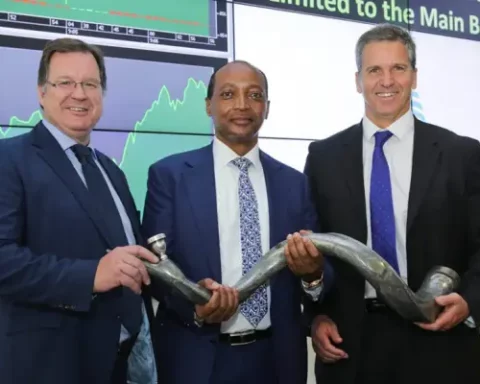The market’s greatest blind spot is often the narrative it believes most strongly.
For the past two years, the spotlight has been on Nvidia’s meteoric rise, fuelled by AI.
Then on a single day, January 27, Nvidia lost nearly $600bn in market value – almost double South Africa’s annual GDP – on news that a relatively unknown Chinese AI start-up had developed a language model at a fraction of the cost of its American counterparts.
DeepSeek was founded in December 2023 by Liang Wenfeng, a Chinese entrepreneur who also created the hedge fund High-Flyer. It released its first AI large language model the following year and, within 24 months, had discovered a more efficient AI training method that challenged the assumption that Nvidia’s graphics processing units (GPUs) are indispensable to the AI boom.
This isn’t just a bump in the road for Nvidia; it’s a warning shot for investors betting that today’s tech incumbents will dominate well into the 2030s.
More to the point, the market’s inability to properly price innovation’s disruptive potential could have major consequences for the wider US equity market over the next decade.
DeepSeek underscores an uncomfortable reality: technology moves fast, and no company, no matter how dominant, is immune to disruption.
While Nvidia has been pivotal to AI’s ascendancy, DeepSeek has proven that state-of-the-art AI models don’t require vast amounts of GPU power. Instead, by leveraging algorithmic efficiencies, DeepSeek trained its model using just 10% of the computing cost of its Western counterparts.
This attacks Nvidia’s two key moats: its hardware stranglehold, and its proprietary software ecosystem.
On hardware, until now, AI researchers and businesses had little choice but to buy Nvidia’s high-margin GPUs, reinforcing a seemingly impenetrable monopoly.
But DeepSeek’s approach suggests that it is actually software that may hold the key to AI’s future. If companies can train models with significantly fewer Nvidia chips, demand for Nvidia’s core product could erode much faster than investors anticipate.
The problem, of course, isn’t just Nvidia; it’s the broader pattern of market extrapolation. When an innovation wave hits, investors tend to assume today’s leaders will be the ones to reap the rewards indefinitely.
But history tells a different story.
Avoiding Cisco’s fate
Take Cisco in the late 1990s. As the backbone of the internet boom, it was widely expected to be a trillion-dollar company, capturing the lion’s share of the digital revolution.
But as internet connectivity became cheaper and competition intensified, Cisco’s margins collapsed. Despite the internet’s explosive growth, Cisco’s stock never reclaimed its dot-com peak. The value shifted elsewhere.
Nvidia could face a similar fate. The AI revolution isn’t slowing down, but the assumption that Nvidia will remain the primary beneficiary ignores the natural tendency of technology to become commoditised.
As competition increases and companies develop their own AI hardware (as Apple, Meta and Microsoft are doing), Nvidia’s pricing power could evaporate. And when your shares are trading at 25 times your revenue with 75% gross margins, any margin compression can be devastating.
But this obsession with Nvidia is emblematic of a larger problem too: the extreme concentration of US equity markets.
Today, just seven stocks – Apple, Microsoft, Alphabet, Amazon, Meta, Tesla and Nvidia – make up roughly 35% of the S&P 500. This is even more concentrated than during the dot-com bubble, where tech’s dominance ultimately led to a lost decade for US equities.
Anton Eser, chief investment officer at 10X, has argued that we may soon face another lost decade for US markets.
Valuations are stretched, with the S&P 500’s CAPE ratio – which compares a stock’s share price to its average earnings over the previous 10 years – now above 38. Historically, these are levels that have never resulted in positive five-year returns.
To complete the picture, corporate debt levels remain elevated, interest rates are no longer falling as quickly as anticipated a year ago, and fiscal headwinds loom large. And yet markets still price US equities as if AI will be a never-ending tailwind without any disruptive downside risk.
Is the US market set for a crash?
DeepSeek’s success forces us to confront this question: if innovation is inevitable, why does the market price it as if it won’t challenge today’s leaders?
The paradox is striking. Investors are bullish on AI’s ability to drive exponential growth but are seemingly incapable of imagining that the same force could unseat the incumbents they’re betting on.
The reality is that AI, like every technological revolution, will evolve in unexpected ways. The companies that initially capture the value may not retain it. And with so much of the US market’s valuation dependent on a handful of high-growth tech stocks, the risk of a severe repricing is real.
For South African investors with growing offshore exposure, this means thinking carefully about US equity risk. The S&P 500 may still be the world’s most liquid and dynamic market, but with extreme concentration and sky-high valuations, the risks of an unwinding are rising.
Diversification into undervalued global assets, including South African equities, offers some protection with far higher margins of safety.
DeepSeek is just the latest reminder that innovation cuts both ways. And if the AI bubble bursts, Nvidia’s recent plunge may be just the beginning of a much larger reckoning for US equities.
Chris Eddy is head of multi-asset funds at 10X Investments.
Sign up to Currency’s weekly newsletters to receive your own bulletin of weekday news and weekend treats. Register here.









